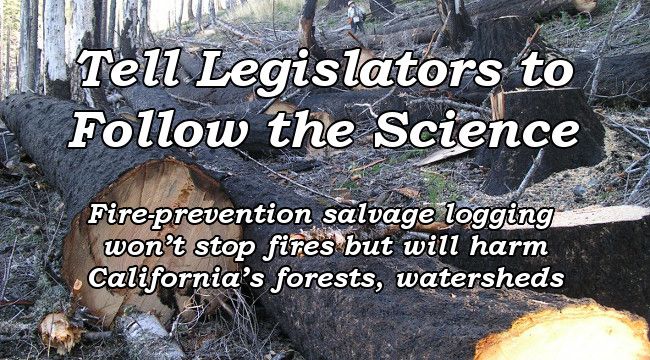| Take Action |
| Donate |
A myth long perpetrated by the timber industry and its enablers in Congress holds that post-fire logging is helpful, even necessary, to recover the forest and to prevent future fires. Nothing could be further from the truth.
Not only is this post-fire logging myth unsupported scientifically, but also a growing body of research has shown that this approach actually substantially increases the risk of wildfire.
Timber companies vie for these "salvage" projects because they provide an opportunity for loggers to cut down the biggest, most profitable — and ironically most fire resistant — trees.
Removing the largest trees and letting stand the smaller, less-merchantable trees leaves behind a forest full of kindling. Removing the forest canopy exposes the understory and soils to direct sunlight and increases the speed of drying winds. Building logging roads and the use of heavy equipment to drag logs further harms the recovering forest by compacting the soil and promoting erosion and sedimentation of lakes, streams, and wetlands.
The same problems arise in connection with many "fuels-reduction" and dead and dying tree-removal projects, in areas not recently affected by fire, conducted in the name of fire prevention.
Tragically, we saw the deleterious effects of logging illustrated last November when the Camp Fire spread through Butte County, taking the lives of at least 85 persons, destroying over 18,000 structures, and incinerating the town of Paradise.
The surrounding area — from Paradise north to Magalia, east to Concow and to the fire's origin near Pulga — had been heavily industrially logged for over 20 years, including by clearcutting and "high-grading" (removing only the large trees). More recently, over the past 10 years, following the Butte Fire of 2008 the area had undergone intensive "fuels reduction" projects conducted to protect the nearby towns from fire.
Yet, far from saving homes and lives, there is evidence that this logging and habitat-removal activity worsened wildfire conditions.
Timber companies conducting post-fire and fuels-reduction projects often utilize expedited "emergency" permits allowing them to bypass public transparency rules and critical environmental oversight.
Forest ecologists argue that we should leave dead standing trees alone. Not only are they generally less flammable than live trees (due to their rapid loss of fine fuels and volatile oils after dying, as well as moisture absorption), but also they serve as crucial habitat for regenerating native species and leave behind nutrient capital to be recycled back into the forest ecosystem.
In fact post-fire or "snag forests" are now recognized to be some of the ecologically richest and most biodiverse forest stands in the West— comparable to, and in some cases exceeding, old-growth forests.
| Take Action |

Paul Hughes
Executive Director
Forests Forever
| Your contribution today will help California's forests thrive! | |
|
RESOURCES →
- John Muir Project's "Logging Didn't Stop the Camp Fire"
- Photos of the Camp Fire, logged and unlogged areas
- Forest Service Employees for Environmental Ethics' "End the Wildfire Wars!"
- George Wuerthner editorial: "'Fuel treatments' don't prevent forest fires"
- Sierra Forest Legacy explains how salvage logging increases fire risk
- "Logging in Klamath National Forest won't stop wildfires. Let it recover naturally" by Jane Braxton Little
- October 2018 research at Portland State University debunks fire-recovery logging
